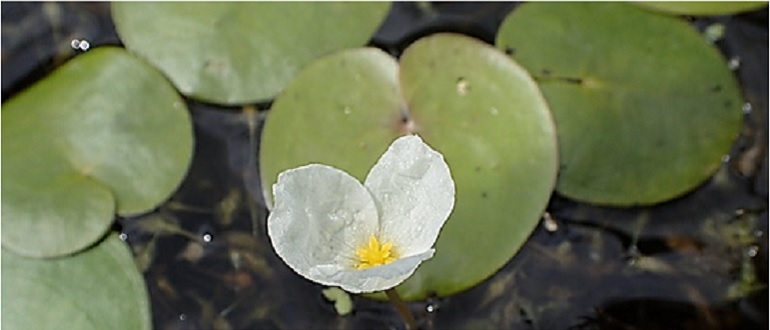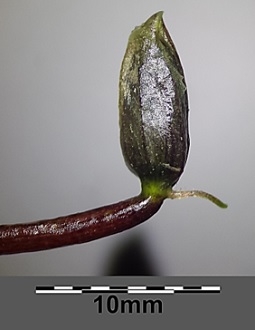GET TO KNOW
European frog-bit
European (or common) frog-bit (Hydrocharis morsus-ranae) is a pretty, free-floating aquatic plant that thrives in still freshwater. It looks very much like a tiny water lily with small, heart-shaped leaves and dainty white flowers. Native to Europe / Eurasia, this plant once thrived across that continent’s extensive freshwater marshes.
Noteworthy Fact: Frog-bit (or frog’s-bit) is a casual nickname used for a number of floating plants. In particular, frog-bit also refers to limnobium levigatum, a South American spongeplant that is widely sold in the US as a pond and aquarium plant. Unfortunately, limnobium levigatum has also escaped to the wild and is becoming an invasive threat on the West Coast. (Please don’t buy it!)
In a sad bit of irony, European frog-bit has now – simultaneously – become an endangered species in Europe and an invasive nightmare in North America. One does have to wonder; how did that happen?
KEY TO THE PUZZLE
According to the EEA (European Environmental Agency) as much as 2/3’s of Europe’s natural marshlands have been lost since the industrial revolution. In some areas, the loss exceeds 80%. Rechanneling of rivers and direct drainage of acreage for agriculture and development have chopped once vast marshes into bits and pieces. Many resident species have ended-up as tiny, isolated populations in random ponds and ditches. Such populations become fragile and highly vulnerable to even small, local threats. European frog-bit – which is susceptible to pollutants from agricultural, urban, and industrial run-off – has reached the critically endangered “redlist” in several countries.
Yet in North America, this European transplant has found a home in the waterways of the Great Lakes basin. Intentionally displayed at the Ottawa Botanical garden in 1932, European frog-bit was presented as a new ornamental pond plant for suburban yards. Unfortunately, frog-bit didn’t stay in its ponds. It escaped.
By 1939, frog-bit had made its way to Ottawa’s Rideau Canal. Since the canal connects to the Ottawa River, frog-bit travelled downstream where it found the St. Lawrence Seaway. It was only a matter of time then, before the “pretty little pond plant” reached Montreal, New York state, and eventually, the Great Lakes. Common frog-bit now colonizes quiet inlets and wetlands around the margins of the Great Lakes. Its massive “rafts” of tangled roots, stems, and leaves clog propellers of ships and impede water travel. Local ecosystems become deprived of oxygen and sunlight, and native species struggle to compete.
It is perhaps, the very interconnectedness of the Great Lakes basin that has led to this invasive success. European frog-bit is an aquatic “hitchhiker” that catches rides on passing watercraft.
Freighters regularly travel the full length of the Great Lakes / St. Lawrence Seaway route. Midwest boating and fishing culture is strong. Small boats and jet skis are hauled here, there and everywhere while canoes, kayaks, and fishing gear are plopped into every bit of water from the closet backyard creek to a faraway marina. Frog-bit simply goes along for the ride. The sheer volume of connected microhabitats allows the plant to flourish.
European frog-bit was first recorded in southeast Michigan in a number of small lakes and impoundments in Oakland County in 2018. It is a prohibited species in Michigan. FOTR has partnered with the Oakland County Cooperative Invasive Species Management Area to survey wetlands in the area to determine how far it has spread. If you live or own property in the Novi, Northville, Farmington, Farmington Hills or West Bloomfield area you may have received a postcard asking for permission to survey your pond or lake for European frog-bit.
PLANT LIFECYCLE
An individual common frog-bit plant lives only a year. During that year, it grows rapidly from a dormant bud to a fully mature, free-floating plant. Each frog-bit plant reproduces prolifically before it dies back in winter’s cold. Once dead, the plant mass sinks to the bottom. Individual plants can grow to cover a square meter of surface area within their single growing season. Since each plant also sends out shoots that sprout new plants, a large colony can easily form each year.
The entirety of the plant floats at the water’s surface. Roots are not anchored, and nutrients are absorbed directly from the water. Each fall, the plant produces as many as 100 hardy “winter buds” called turions that are released to float away. It is the turions, each slightly larger than a grain of rice, that hitchhike their way to new locales. Eventually, turions sink and remain dormant through winter. Come springtime, the turions sprout and float up to the surface to form a brand new colony.
TAKE ACTION
It is generally considered to be impossible to eradicate European frogbit from the Great Lakes basin. However, small populations can be managed by diligent hand pulling and removal of floating plants during the summer season. This process must be completed before mature turions are released by parent plants in fall. Additionally, once a large frogbit colony has become established, a regular removal process will generally need to be an annual event.
All users of our waterways can help stop the spread of European frog-bit (and other invasive species) by practicing proper cleaning habits when boating, fishing, or even playing in water. It is important to properly clean and dry all equipment (including boat hulls and bait wells) between uses to prevent transportation of “hitchhiker species” between locations. Also, never dump leftover bait in the water (or on land). Properly dispose of all leftover bait in the garbage. For more information on best practices, please see Stop Aquatic Hitchhikers
If you have a backyard pond, resist the temptation to bring in exotic plants. While European frog-bit is not offered for sale in the state, residents could encounter it and decide to move it to their pond without understanding the dangers of its growth and spread. Other invasive aquatic plants like water hyacinth and water lettuce are not yet prohibited but pose the same threat to our waterways. Don’t buy them.
You can assist in preventing the spread of European frog-bit by learning how to recognize it and reporting any findings to the Michigan Invasive Species Network. If you live in the target area or received a postcard, please respond ASAP and give us permission to survey your waterway. The information will be used to understand the extent of the infestation in the watershed and to design a management plan for Oakland County. For more information about FOTR’s surveys or to attend a webinar, visit Frogbit Survey Project
MAIN PHOTO CREDIT: European frogbit (Hydrocharis morsus-ranae) – Jeremy Halls (CC-BY-SA-2.0, image cropped)


